29 July 1971
by Tom Hildreth
In the summer of 1966, American Airlines circulated a request to the aviation industry for a 250-seat wide-bodied aircraft powered by two engines that offered medium range capability. It was felt that an aircraft in this size range would help reduce congestion at many of the nation's airports. In response to this request, Douglas consulted with other airlines and concluded that a larger three-engine aircraft was needed, with a capacity of 250-350 seats. The airlines required the new aircraft be entered into fleet service without change to airport infrastructure, and be capable of full-load operation from hot-and-high airports such as Denver’s Stapleton Field. By early fall of 1967, McDonnell Douglas confirmed their market research and settled on a wide-body design with a capacity of between 250 and 340 seats. Rather larger than American’s original request, the Douglas DC-10 would have three engines, and a 35-degree swept wing incorporating high-lift devices. Douglas had great success “stretching” both its DC-8 and DC-9 series to accommodate increases in payload and range. This business fully occupied the Douglas staff at the time of the DC-10s inception, and only through the merger with McDonnell was there an infusion of cash and management direction with which to proceed on the new aircraft. The DC-10 was designed with growth in mind, and engineers provided space for a third main landing gear leg in the center of the fuselage for larger and heavier intercontinental versions of the new airliner that were to follow. Jet engine technology was changing rapidly at the time, with the manufacturers capitalizing on the success of the first generation of turbofans. The goal now was the introduction of large high-bypass turbofan engines, and the DC-10 design team found three such engines under development that would be candidates to power the DC-10. These were the General Electric CF6; the Pratt and Whitney JT9D; and the Rolls Royce RB.211. Versions of the first two engines would eventually power the new airliner, and the straight-through duct of the center engine, located at the base of the vertical stabilizer, provided accommodation of different engines with relative ease. On 19 February, 1968, American Airlines placed an order for 25 CF6-powered medium-range DC-10-10s, with 25 additional aircraft on option. This quantity was not sufficient to order the aircraft into production, and in late April, 1968 when United Airlines ordered 60 CF6-powered DC-10-10s, with 30 on option, the production go ahead was given. The DC-10-10 was produced for the US domestic market, with a cockpit crew of three, which consisted of a pilot, co-pilot, and flight engineer. Maximum take-off gross weight (MGTOW) of this model was initially 410,000 lb., and grew in stages to 455,000 lb., as increased FAR runway length requirements were observed. The first DC-10-10 deliveries were to American Airlines and United Airlines, taking place at a joint ceremony at Long Beach, CA., on 29 July, 1971. American was the first to introduce the DC-10-10 into revenue service, when on 5 August, 1971, they began operating the type between Los Angeles and Chicago. The time that elapsed between production commitment and first customer delivery was less than three and a half years. By comparison, today, in an era where it takes at least a dozen years to introduce a new aircraft, and ten years to introduce a not-really-successful computer Operating System, we seem to be introducing new technology at a glacial pace. DC-10-10 production totaled 122 machines, with American, Continental, Delta, National, United and Western Airlines being the recipients of Long Beach’s output. In addition, two foreign operators, Laker and THY, ordered the DC-10-10. The final DC-10-10, msn 48263 N1847U, was delivered to United Airlines on 20 April 1981. In production for over 20 years, a total of 446 DC-10s of all types were produced. Unfortunately, this was less than half the sales goal envisioned by McDonnell Douglas at the outset. The author would welcome contact with anyone with additional photos and comment on the McDonnell Douglas DC-10. | ||||||||||||||
|
Click each photo below for large version |
|||||||||||||
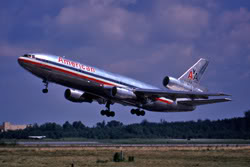 DC-10-10 N102AA msn 46502 of American Airlines at Hancock Fld, NY 19 Aug 1972. |
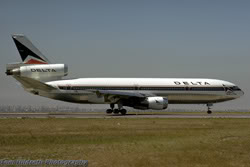 DC-10-10 N603DA msn 47967 of Delta Airlines, leased from United Airlines while the former waited for the L.1011 problems to be resolved. JFK 27 April 1974. |
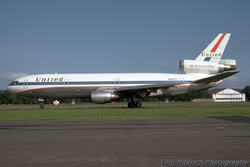 DC-10-10 N1807U msn 46606 of United Airlines at Bradley Field, CT on 6 July 1974. |
||||||||
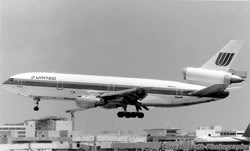 DC-10-10 msn 46636 N1843U of United Airlines at Miami, March 1989. |
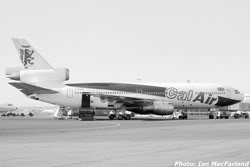 DC-10-10 G-BJZD of Cal Air at Newcastle on 30 September 1986 by Ian Macfarland. |
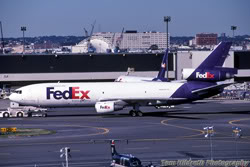 DC-10-10CF N68056 msn 47810 of Fedex at Boston 11 July 2000. |
|||||
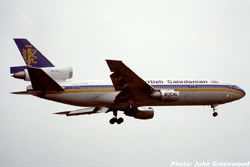 DC-10-10 G-BJZE msn 46973 of British Caledonian at Manchester, 1983 Photo by John Greenwood. |
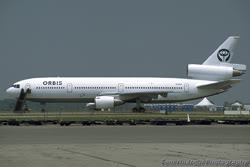 DC-10-10 N220AU of Orbis at Hamilton, ON 15 June 2001. |
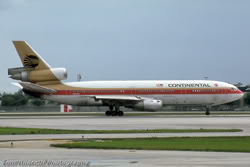 DC-10-10 N68046 msn 47800 of Continental Airlines at Miami, 3 August 1985. |
||
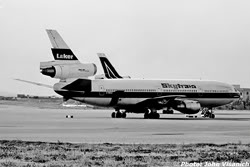 DC-10-10 G-BBSZ of Laker Skytrain at Luqa, Malta 12 June 1978. Photo by John Visanich. |
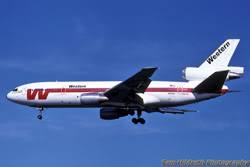 DC-10-10 N909WA msn 46983 of Western Airlines at LAX, 24 January 1981. |
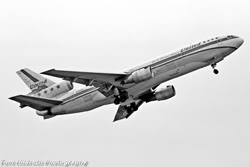 DC-10-10 msn 46609 N1810U of United Airlines at JFK 28 February 1976. |
| HOME |
| EMAIL Tom Hildreth |